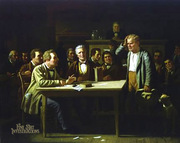The Artist at Center Stage
The Puzzled Witness, 1874, is George Caleb Bingham’s often overlooked last genre work. For 40 years, Bingham witnessed the people and the the politics of Missouri, and the nation. With hard-earned artistic skill and well-reasoned political perspective, he portrayed his observations. Sometimes he put himself in the picture as one of many characters in a scene, usually as the one recording the events. In The Puzzled Witness, he placed himself at center stage for the first time[1] and evaluated his role as witness.

Oil on Canvas, 23 x 28 inches
Private Collection
Setting
Unlike Bingham’s best-known colorful, active outdoor paintings of the antebellum years, Puzzled Witnessis set in a dark, motionless interior. This last genre scene is even darker that his earlier genre works such as Country Politician, 1849, or The Checker Players, 1850, and lit more dramatically. The composition’s asymmetry focuses the viewer’s eye on the witness. He is a short man clothed in plain homespun. He wears boots and clutches a rumpled hat. His dog sits behind him. The rest of the men in the room wear shirts with stiff upturned collars, suits, vests and shoes. The witness is the only participant who does not a tie. The defense attorney sits at the end of a cluttered table. Scraps of paper have fallen to the wooden floor. The clutter is reminiscent of the symbolic disorder in the foreground of Raftsmen Playing Cards, 1847, or In a Quandary, 1851. Bright light on the clear portion of the tabletop draws attention to the witness’ empty white shirt. This focus has no other precedent in Bingham’s work.
Meaning
In 1874, a St. Louis art critic interpreted The Puzzled Witness:
The artist has seized upon the strong moment. The witness for the prosecution is up, and the attorney for the defense has just put a puzzler to him. It is a stunner. The witness is, in point of fact, stumped. He scratches his head for the answer, but it don’t seem to be there, or perhaps, it is a neat bit of acting.
Missouri Statesman, 11 December 1874
In contrast to the forthrightness of Order No. 11 (see below), Bingham reveled in ambiguity in The Puzzled Witness. The St. Louis art critic could not determine if the witness was truly “stumped” or acting.
In 1874, nearly a decade after the end of the Civil War, some of the Missourians displaced by Order No. 11 had returned to the region. They, and those who had remained in the region throughout the war, tried to recover their lives, but many were disenfranchised. To assimilate into the post-war world, these usually rural folk had to dissemble their true feelings. They had not yet forged a Midwestern identity to circumvent the Union-Confederate division. The Puzzled Witness may represent their awkward circumstances.
Self-Portrait?
Even more, the painting addresses Bingham’s feelings. George Caleb Bingham is the puzzled witness. Before and during the Civil War, Bingham worked for a unified nation with a strong central government. When that same government failed to halt the atrocities of total war on the western frontier, as he later memorialized in Order No. 11 / Martial Law, his faith diminished, but he continued to serve as state treasurer for Missouri’s Union government. The wounds of war were still too fresh for others to comprehend his distinction between questioning of the excesses of governmental power versus treasonous criticism. These misunderstandings of the painting’s intent by critics and viewers widened his personal ideological rift. Later, the government denied him compensation for his Kansas City home that was confiscated and destroyed by Union soldiers. Still he worked as Missouri’s Adjutant General to help other victims receive justice. He’d been a Whig, upholding republican principles for most of his life, but by 1878, his devotion to a strong federal government wavered. He had married a relative of Stonewall Jackson and asked to be buried facing south. The resemblance to the central character and to Bingham can be seen in an 1878 photograph: straight bushy eyebrows, square face, strong chin.((Michael Edward Shapiro posited the theory that George Caleb Bingham himself is the “bewildered” witness in George Caleb Bingham, (Harry N. Abrams and the National Museum of American Art, 1993), 135, 137.))

George Caleb Bingham, The Puzzled Witness, 1874 (Detail) 
George Caleb Bingham, 1878, Photograph
The Puzzled Witness gazes at the tabletop. The clutter may symbolize the complicated history he witnessed. After the Civil War and during and after Reconstruction, there was no easy answer for life at the Kansas – Missouri border or for an artist of deep thoughts and feelings.

